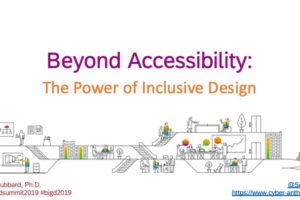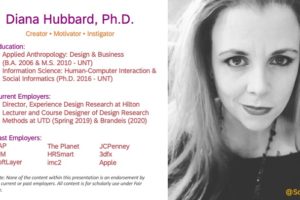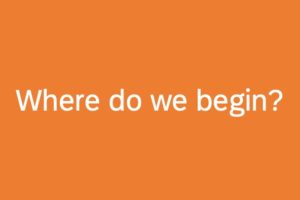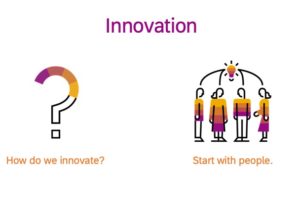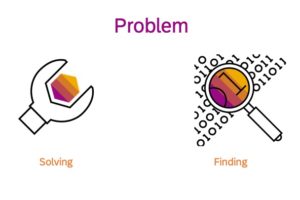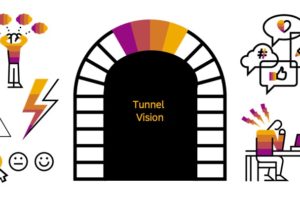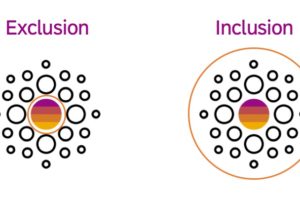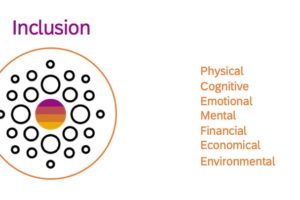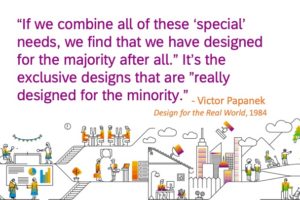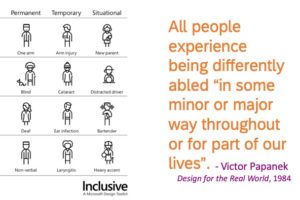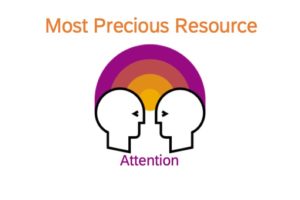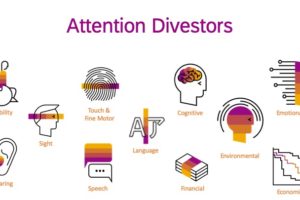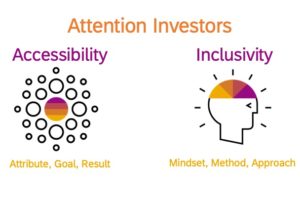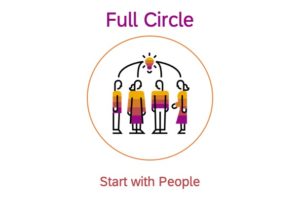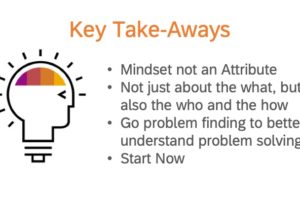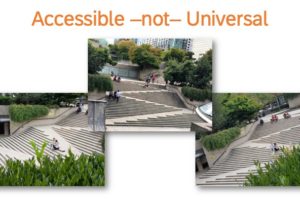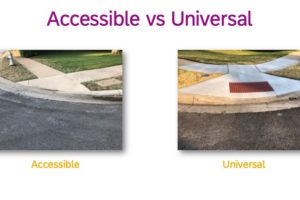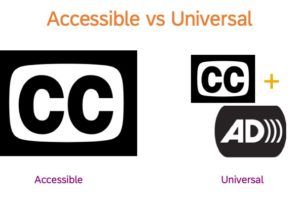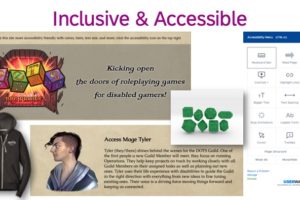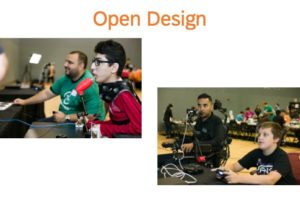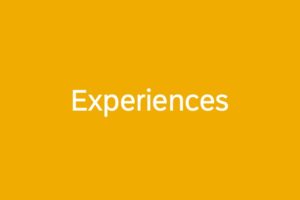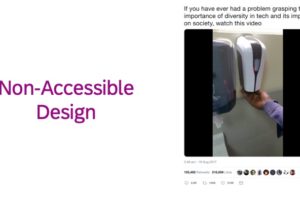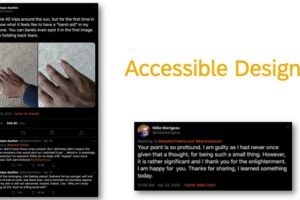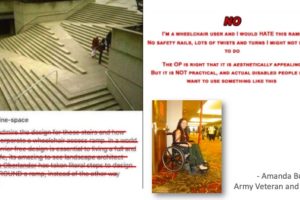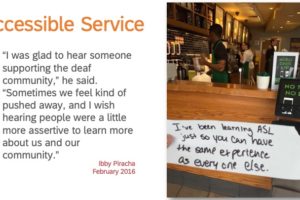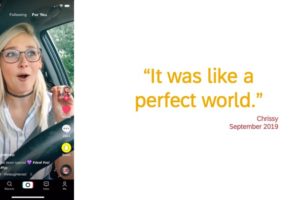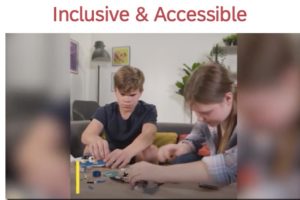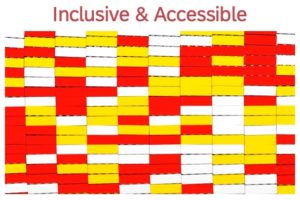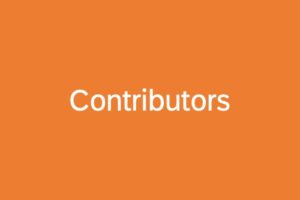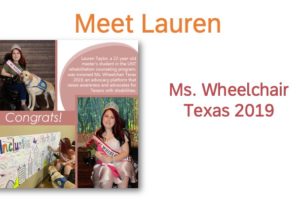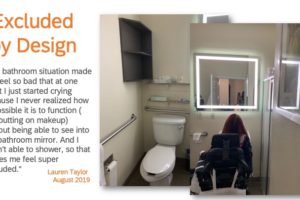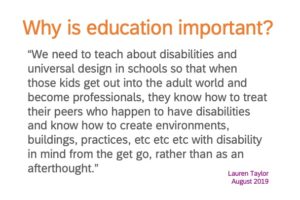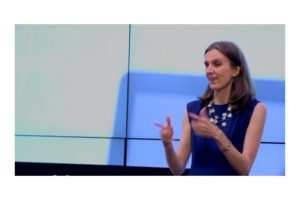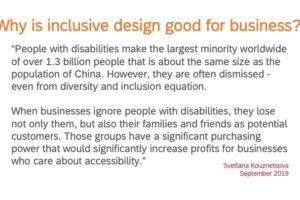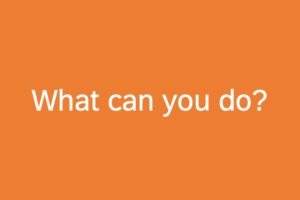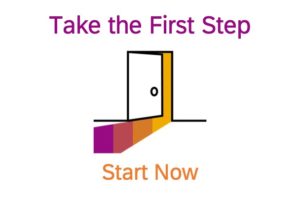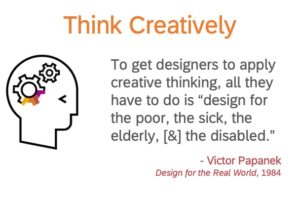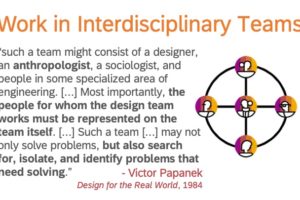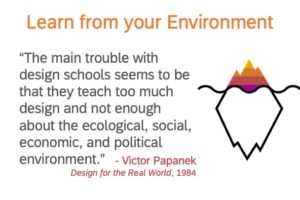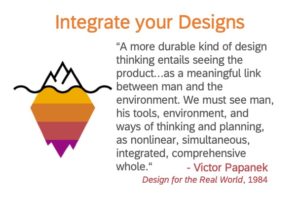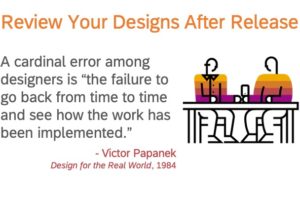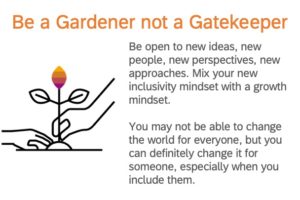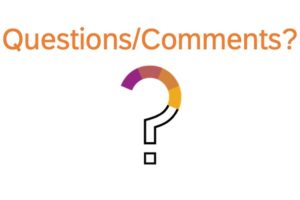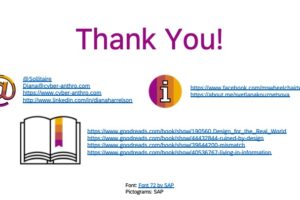This is a presentation I gave twice last year on inclusive design. Why did I choose this topic? Well, it’s become quite the buzzword that people often use without truly understanding what it is. The most common notion I’ve seen is that it is simply designing something with accessibility in mind. But, that just gets to the end result and doesn’t necessarily do it well.
The simple condensed message of this presentation is that inclusive design is about the process of design. It is about INCLUDING people from diverse backgrounds as well as those with diverse abilities in the designing activities and not just as a potential user for which the product or service is designed.
To learn more, please take a gander through my slides below, view the actual presentation, or read my writeup.
- Presented at Big Design 2019 and DFW Beyond 2019
- None of the content within this presentation is an endorsement by my current or past employers.
- The eternal question
- I often get asked, well how do you innovate? You start with the people of your business or organization and those who buy your products or services, especially those who have additional needs to be able to navigate the world successfully.
- Most people approach innovation through problem solving (or solutionizing from the get go) when in reality, they should go problem finding before they even attempt to solve the problem they think they know.
- If you already believe you know what problem you're solving for, then you end up with tunnel vision and automatically exclude all of the other opportunities.
- The best way to describe inclusion is that it is the opposite of exclusion.
- Inclusion means going problem finding with people who are very familiar with finding problems with most environments, products, and services including disabled people. This list is just a few ways people can be disabled.
- Inclusivity's focus is the broadest group of people possible including disabled people. People who benefit from inclusivity the most are those who are traditionally affected the hardest when their needs go unmet. WHO 2011 15-20% world pop disabled Up to 4% significant difficulties functioning - rising number due to aging pop, spread of chronic diseases, and improvements in diagnosing disabilities
- Not all people who are disabled are disadvantaged in the same way and not all are treated the same in our society We need to also consider their gender, ethnicity, cognition, and mental health Those disproportionately affected are low income, women, ethnic minorities, and the elderly Age is something that will affect us all regardless of how much money we make, our gender, or our ethnicity - given the universality of it, it makes for a great example for innovation opportunities
- Our experience in being differently abled differs between people, abilities, tasks, and situations. The one thing that is constant is that in all of these cases we have a greater potential to be robbed of our most precious resource.
- Depending on where you live in the world race, gender, and religion may also play a part. The great divestor for all is age.
- An important distinction is that accessibility is an attribute, while inclusive design is a method. While practicing inclusive design should make a product more accessible, it's not a process for meeting all accessibility standards. ... Another concept that is closely related to inclusive design is universal design. OCT 16, 2018 - KAT HOLMES https://www.fastcompany.com/90243282/the-no-1-thing-youre-getting-wrong-about-inclusive-design
- Two more terms you may hear when people bring up accessibility and inclusivity are Universal Design and Open Design. Inclusivity is to electronic interactions/machine interfaces as Universal Design is to physical actions. Universal design is about making some thing or place or space usable by the largest amount of people without the need for adaptation. Whereas open design is about including others in your design process and making the process of design open to all. Here is where you get into things like open innovation, co-innovation, participatory design, and open source technology. https://www.udll.com/media-room/articles/the-seven-principles-of-universal-design/
- In the end, it all starts by being inclusive in the people you work with throughout the design of your product or service.
- This stairway is located in Vancouver, Canada. While it seems accessible, and it is true that it allows for people to move up the space without having to use the stairs, it isn't universal because those people who have to use a ramp are less inclined to use this one due to the way it is designed. This is touched on again later in the presentation.
- These are taken in my own neighborhood. All of the curb cuts looked like the accessible one. As you can see, the universal one is new. This is the only street in my neighborhood that has a universally designed curb cut and they had to tear up the old one to put the new one in. This meant it took MORE money to do it right the second time. As a side note, noticing the handicap school bus that goes down that street, it is my guess there is a child who needed this design and that's why it was put in. Unfortunately, it is the only street that has it so this limits this child's travel to a single cul-de-sac.
- Closed captioning is one of the accessibility features many of us are familiar with, but it is only one side of the coin. The other side is descriptive audio for the blind. https://www.acb.org/adp/ad.html Additionally, closed captioning and audio description are more than just putting words on a screen or saying out loud what is happening. There is an art to it. We will get to that a little later.
- https://www.dotsrpg.org/ - You can download the plans for the dice for free if you have a 3d printer. Otherwise, they have loads of stuff that make playing table top games more accessible and on their staff are people who contribute to the project through their own experiences of requiring accessible products and services.
- https://www.neilsquire.ca/electronic-arts-employees-to-build-assistive-technology-for-gamers-with-disabilities-in-vancouver/ Though universal design states that things should be usable without adaptations, sometimes adaptations are required to make things usable for people with disabilities. This pair up of a gaming company and a society to bring technology to people who are disabled used open design to help design adaptations to controllers for people with disabilities to help them be able to play games. This is not an endorsement by my employers.
- This is a video in the presentation. It shows that dark skinned hands do not activate the sensor for the dispenser. It's not just exclusive because it excludes people from using it, but you can tell the design process wasn't inclusive as this was never even tested with people other than those who built it! https://twitter.com/nke_ise/status/897756900753891328?lang=en
- https://twitter.com/ApollonTweets/status/1119276463016951808 https://www.theroot.com/it-s-not-about-the-band-aids-1834387539 Notice not only how this made the original poster feel, but also how it opened the eyes of others. That is what inclusive design is all about. Including diverse people from different backgrounds and with different experiences in your design process so that as a team you can become greater than the sum of your parts.
- https://www.facebook.com/photo.php?fbid=10156523082563063&set=a.391021293062&type=3&theater used with permission
- https://www.washingtonpost.com/news/local/wp/2016/02/22/this-starbucks-barista-learned-sign-language-to-communicate-with-her-deaf-customer/ The best time to start being inclusive is NOW. If you know it will make someone's life better, just do it.
- This is a video in the presentation. Originally on TikTok. Used with permission.
- This is a video in the presentation. https://www.washingtonpost.com/lifestyle/2019/08/28/lego-just-released-audio-braille-instructions-they-did-it-because-blind-man-who-never-gave-up/ The idea that sight is knowledge and by giving people the ability to embrace previously inaccessible knowledge sighted people take for granted through building things on their own is awe inspiring.
- This is a video in the presentation. https://www.legobraillebricks.com/ The concept presents a groundbreaking and inclusive opportunity to teach blind, visually impaired and sighted children alongside each other by offering a fun and playful way to engage, interact and learn together.
- Far be it for me an abled bodied person to speak to this without consulting with people who have a much better perspective. The following are two stories that were shared with me for this presentation.
- Her platform is Universal Design for Inclusion because of her passion to create a barrier free world where people with and without disabilities can coexist with ease. She hopes to bring the concept of universal design across Texas to businesses, schools and communities to create environments of equal benefit to all members of society. I interviewed her for her perspective on inclusivity and universal design.
- Let's start with the bathroom. The sink was basically what you'd see in a prison cell. No counter tops... just a single sink with no surface area for putting anything on it like soap or makeup. The mirror WAS ABOVE MY HEAD. The only shelving was above the toilet in the form of corner shelves, so no possible way to access them. The door opened into the bathroom. The shower bench was moldy and gross with no way to get to it in a wheelchair... I digress.“ Interview with Lauren Taylor As a note this was not a Hilton hotel.
- So at my university (University of North Texas), I was tired of going to the classes I signed up and paid for and NOT HAVING A DESK TO SIT AT. Everyone else pays for a seat and gets one. I pay for a seat and get an empty space on the floor. So I sought out to solve it. I designed a desk that will only be usable/functional if it is bolted to the floor. It essentially looks like a speaking podium with no base/legs. This is to solve the theft problem of people taking the desks for their own reasons once they are placed in a students classroom as a requested accommodation. The desk is height-adjustable with plenty of knee clearance and the top will flip upwards to get out of the way if the user needs more space to situate into the spot. I am very proud of this solution and hope to see it installed in universities across the country. A desk should not be an accommodation to be requested. It should be something available in any classroom. And it is universally usable to any student. Just pull up a chair if you are not in a wheelchair or scooter, so it is not taking seating capacity away from others. Interview with Lauren Taylor
- Sometimes it surprises me how little the general public knows or realizes about accessibility. Unless it directly affects them, they have absolutely no realization or understanding of what access even entails for people with disabilities. If they do have to implement access somewhere, they think that a ramp here and an elevator there is substantial enough. They do not actually know or understand the access needs of someone with a disability out in the community. They don't understand why it is degrading to have to enter through the back kitchen staff entrance just to eat at a restaurant. They do not understand the embarrassment of being escorted via service elevator to get to an upper floor of a building, like some piece of equipment being delivered rather than a human being. They see us as a tiny minority that doesn't matter enough to permanently accommodate. They do not understand that universal design would only expand access to us in addition to them, rather than taking something away from them for solely our benefit.- Interview with Lauren
- Svetlana Kouznetsova (Sveta) is a NYC-based user experience and accessibility consultant helping businesses make their products and services user-friendly. She has an MS in Internet Technology, several advanced certificates, and project experience with national and international organizations and educational institutions. Sveta also provides consultation and training to businesses about quality captioning and other types of communication access to audio, video, events. She is an international speaker and author of a book, Sound Is Not Enough: Captioning as Universal Design. Sveta's TEDx talk uncovers benefits of captioning access that increase audience and ROI for businesses. Her daily experience with deafness and communication barriers gives people an exceptional insight into her professional experience and expertise in accessibility. I interviewed her for this presentation.
- This is a video in the presentation: https://youtu.be/ngKp9MqUGj8 Machine-based captioning is often described as craptioning. Captioning requires finesse and there's an art to it.
- Src: Interview with Svetlana https://www.worldbank.org/en/topic/disability
- Other people who have provided info on this topic have been criticized for not providing examples of what to do - the following aims to help fill that gap.
- Remember, this is a mindset not a feature. You don't need permission to adopt a new way of thinking. The rest of these 'steps' are recommendations from Victor Papanek 35 years ago.
- Start from this perspective every time you approach a new design project. It will get your creative juices flowing to consider things from completely different perspectives. Then, bring people who live those perspectives into the mix to validate and improve upon your ideas.
- If you're doing any sort of design thinking exercises, GET THE RIGHT PEOPLE IN THE ROOM including actual end-users from all ends of the spectrum with all sorts of abilities. This is essential. Also, make sure YOUR OWN TEAM IS DIVERSE! Differently abled people and people with very diverse backgrounds can only improve your team. You will design better when working with them. It's guaranteed. https://builtin.com/diversity-inclusion/diversity-in-the-workplace-statistics INCLUSIVE COMPANIES ARE 1.7 TIMES MORE INNOVATIVE When compared to other companies in the same industries, those that are not only diverse but inclusive are much more likely to be leaders of innovation. INCLUSIVITY LEADS TO SIGNIFICANTLY HIGHER CASH FLOW PER EMPLOYEE Over just three years, companies that have a highly inclusive culture notice 2.3 times more cash flow per employee. INCLUSIVE COMPANIES ARE 120% MORE LIKELY TO HIT FINANCIAL GOALS When people feel included at work, they're better able to band together and are much more likely to meet their financial goals. PLUS, HIGHLY INCLUSIVE COMPANIES SEE 1.4 TIMES MORE REVENUE All that talk about bringing people together and building an inclusive workplace culture actually does pay off who knew people really do work harder when they enjoy being at work! INCLUSIVE COMPANY CULTURES LEND TO MILLENNIALS BEING MORE ENGAGED WITH THEIR WORK When companies foster a more inclusive work environment, a whopping 83% of millennials are found to be actively engaged in their work. RACIALLY & ETHNICALLY DIVERSE COMPANIES ARE 35% MORE LIKELY TO PERFORM BETTER Companies with significantly more racial and ethnic diversity, when compared to other similar companies, are much more likely to outperform competitors. GENDER-DIVERSE COMPANIES ARE 15% MORE LIKELY TO HAVE HIGHER PERFORMANCE In addition to racial and ethnic diversity, gender diversity is a key player in boosting performance in the workforce. DIVERSE COMPANIES ARE MUCH MORE LIKELY TO CAPTURE NEW MARKETS Diverse companies are significantly better positioned, 70% more, to capture new markets. And with more markets comes higher performance and more money. DIVERSE TEAMS ARE 87% BETTER AT MAKING DECISIONS Compared to individual decision makers, diverse teams make better decisions 87% of the time.
- Don't reinvent the wheel just because it was used on a different mode of transportation. But do try to see how you can make it easier to use by people with all sorts of abilities.
- Our products are not an island unto themselves. We produce products and services that operate within a larger ecosystem. We must understand how it all interrelates, especially amidst the current social, political and economic climate that exists today.
- Integrated design is not a set of skills, techniques, or rule but should be thought of as a series of functions occurring simultaneously rather than in a linear sequence. Design thinking needs to integrate the end-user and their environment as a part of the process. Failing to do so leads to tunnel vision focusing on solving problems already known rather than problem finding for problems that will help you truly innovate.
- In our fail-fast design culture, there isn't always time (or approval or acceptance) of research prior to release. If you find yourself in that type of culture, you should do your best to try to change that. Whether you are able to do research prior to release or not, you should ALWAYS review your designs after their release. Both by observing the interactions of the design itself and by observing the environment that provides the backdrop for its existence. And you should make it a point to do this with a diverse group of people including people who are disabled.
- We've all heard 'everyone is a designer' and some of us turn up our noses at this, but let's step back a moment and really consider that from an inclusive perspective. Yes, to be inclusive, everyone IS a designer. Your job as a CAPITAL D Designer is to help everyone with their design ideas. Help bring them to life. Help them evolve and become something. Recently, I read Mike Monteiro's book 'Ruined by Design' where he stated 'Designers are gatekeepers' but really, I think I like Jorge Arango's approach in Living in Information of 'Gardeners' much better as it also relates to Papanek's designers as 'seed projects' in helping teach other designers to fulfill their own needs. I get the point Monteiro was trying to make about us being Gatekeepers in preventing bad designs from existing, but if we consider the concept of being a gardener then we are where ideas come to germinate and we are responsible for providing the correct environment for that germination to happen while also be conscientious of the external environments in which our garden grows. As capital D Designers, we are the people that help grow ideas, give them shape, form, and function. The seed may belong to us or someone else, it doesn't matter. What matters is that we do our jobs to help grow the ideas and to do that we need to be inclusive so that it gets the right inputs like sun, soil, and water to bring it to fruition. As all gardeners know, it's not planting the seeds that's the hard part. It's keeping them alive. When we tend to our garden we come back to it over and over again to help it succeed. It takes a lot of effort, but it's worth it in the end. If we are good gardeners, then we don't have to be gatekeepers.
- Things I didn't get to: AI Algorithms Environments & Economies already affected by Climate Change & Pollution & Political unrest & Poverty Really, I could teach a class on this! There is so much more we need to consider here. Designers and researchers need to be a part of designs that are seemingly 'backend' because they all touch humans in some way and we are the people responsible for that human interface in one way or another. Just because it doesn't have UI doesn't mean we don't have a part to play. Think outside the pixels. Questions or comments - post them to the writeup https://www.cyber-anthro.com/2020/04/beyond-accessibility-the-power-of-inclusive-design/ or use my contact me!
- Active links are provided in my writeup here: https://www.cyber-anthro.com/2020/04/beyond-accessibility-the-power-of-inclusive-design/
